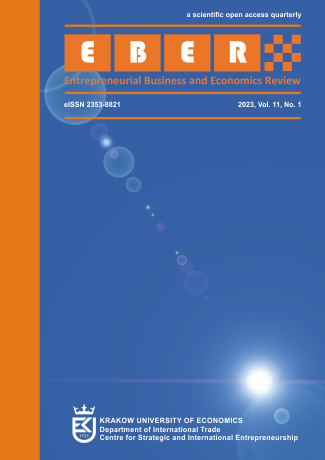Determinants of export activities in Ukrainian regions in the pre-conflict and the first-stage conflict periods

Abstract
Objective: The article aims to explore the impact of main factors on the export dynamics of Ukrainian regions in the pre-conflict and conflict periods.
Research Design & Methods: The article investigates the relationship between the regional export performance and main factors influencing its development in Ukraine, based on regional data of the State Statistics Service of Ukraine and the National Bank of Ukraine for 2003-2019. The article focuses on the analysis of export dynamics in Ukraine. Moreover, the analysis investigated the impact of the war conflict on the export development, which was estimated as the change in the level of export. It was evaluated using the differential intercept dummy variable, as well as the change in the slope coefficient, the extent and significance of which were assessed employing slope dummy variables for every explanatory factor. The analysis was performed for coastal, non-coastal regions, and the country level separately. The modelling procedure included all standard methods for panel data analysis. Based on its results, the one-way fixed effects model was selected as the most suitable for the performed analysis.
Findings: The obtained results confirmed that the export dynamics in coastal and non-coastal regions was affected by the spread of the war conflict to a different extent. This was expected due to the closer location of coastal regions to the war zone. This disparity was especially seen because of significantly different relationships between exports and imports in coastal and non-coastal regions, which deepened even further during the conflict period. Another interesting finding was the decrease of the production’s influence on exports in coastal regions in the conflict period, which was strongly linked with the spread of the conflict.
Implications & Recommendations: We suggest that the decline of the industry’s impact on export trade was a consequence of the war in Ukraine. Thus, new priorities should be identified in terms of the development of Ukrainian industry to minimize the negative influence of the conflict on this economic sector, enhance the quality of manufactured goods, and improve the access of the country’s companies to international markets. In this context, it is important to continue Ukraine’s further integration with the European Union and to deepen industrial cooperation with the EU, the USA, and other countries. Taking into account the existing situation in the country, the mechanism for attraction of foreign direct investment should be also improved.
Contribution & Value Added: The novelty of our article is that the influence of industry on exports of Ukrainian regions was investigated, considering coastal and non-coastal regions in the pre-conflict and conflict periods separately. The article contributes to the development of the theory and practice, because it enhances the understanding of how the conflict impacts relationship between the selected determinants and regional export activities. The change of the export dynamics in coastal and non-coastal regions can be used as the case study for comparison of regions which are more (coastal) and less (non-coastal) affected by the war conflict.
Keywords
Ukraine; industry; export; regional development
